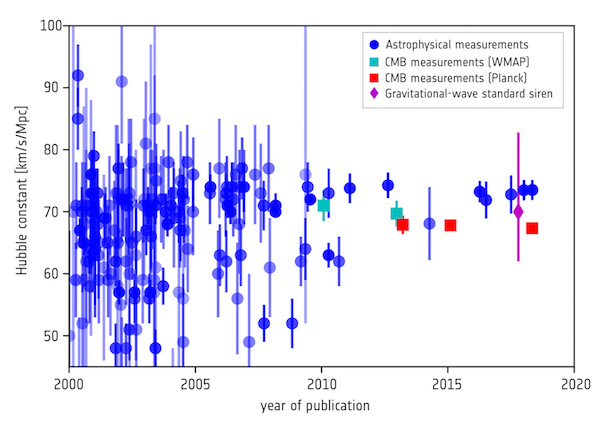Tau.Neutrino said:
Dark energy: Map gives clue about what it is — but deepens dispute about the cosmic expansion rate
Dark energy is one of the greatest mysteries in science today. We know very little about it, other than it is invisible, it fills the whole universe, and it pushes galaxies away from each other. This is making our cosmos expand at an accelerated rate. But what is it? One of the simplest explanations is that it is a “cosmological constant” – a result of the energy of empty space itself — an idea introduced by Albert Einstein.
more…
Thanks for that. I need to know more about eBOSS.
I did mention eBOSS briefly in a recent thread. og, no I didn’t, but eBOSS is one of the “five separate independent sources” I mentioned from the year 2018. This post.from https://tokyo3.org/forums/holiday/topics/14018/
> mollwollfumble said:
>> The Rev Dodgson said:
>>> mollwollfumble said:
>>> … until it was mostly solved in 1998 with the discovery of dark energy.
>> All very interesting thanks.
>> But shouldn’t that be “with the hypothesis of dark energy”?
> No. ‘Dark energy’ is well known and understood. It’s ‘dark matter’ that can still be called a hypothesis.
1993. Kofman. Results from the COBE spacecraft strongly suggest what is later to be known as dark energy. See chart below. Here ‘h’ is the Hubble constant with a value of 1 representing 100 km/s/Mpc. Ω is the fraction of baryonic matter plus dark matter. 1-Ω is the fraction of dark energy. The case of no dark energy Ω=1 would require either a low age for the universe of a low value for the Hubble constant, neither of which agrees with previous observations. Note the maximum value of the Hubble constant of about 80 km/s/Mpc. (Dark energy itself wasn’t officially discovered until five years later).
1998. Branch. This was the year in which dark energy was discovered but, just before dark energy, this paper had appeared on the measurement of the Hubble constant using Cepheids and Type 1a supernovae, following on from Arnett and Bartell mentioned above. The Hubble constant is in the range 54 to 67 km/s/Mpc or, being more lax, 60±10 km/s/Mpc.
2003. First year data from the Wilkinson Microwave Anisotropy Probe (WMAP). The Hubble constant best fit is 72±5 km/s/Mpc. With further external data this is improved to the range 68 to 75 km/s/Mpc. (Notice how this is remarkably close to Sandage’s value of 75 km/s/Mpc from way back in the year 1958).
2012. Data from nine years of operation of WMAP. The Hubble constant best fit is 70.0±2.2 km/s/Mpc. With further external data, including Baryon Acoustic Oscillation, this is improved to the range 69.32±0.80 km/s/Mpc.
2013. First data release from operation of the Planck spacecraft. The Hubble best fit is 67.4±1.4 km/s/Mpc. With further external data this is improved to the range 67.80±0.77 km/s/Mpc.
2018. Final data release from Planck, https://en.wikipedia.org/wiki/Planck_ . The Hubble best fit with further external data from five separate independent sources is 67.66±0.0.42 km/s/Mpc. This corresponds to an age of the universe of 13.787±0.020 billion years.
Summary.
- The “constant” in the compound noun “Hubble constant” refers to constant at the present time rather than constant since the big bang. In practical terms it means constant out to a red shift of 0.3.
- The first measurement of the Hubble constant is in 1929, or thereabouts. But the value is out by a massive factor of 8, giving an impossibly small age for the universe. Only Oort realises how huge the error margin is.
- In 1956, it is found that some stars are older than the age of the universe. This disagreement between the two ways of measuring the age of the universe causes quite a ruckus, and persisted until solved by the discovery of dark energy in 1998.
- The first even remotely reliable measurement of the Hubble constant was by Sandage in 1958.
- The discovery of dark energy by Rubin in 1970 makes the problem that some stars are older than the age of the universe much worse.
- The first time anybody ever did a reliable calculation of the error bars on the measurement of the Hubble constant was in 1998. Before then, the error bars were either way too small (eg. Hubble) or way too large (eg. Sandage).
Now I want you to keep in mind that error bars are often calculated very wrongly. The following chart is from https://sci.esa.int/web/planck/-/60499-from-an-almost-perfect-universe-to-the-best-of-both-worlds

Now back to OP.
From eBOSS: “our measurement of the current rate of expansion of the universe is about 10% lower than the value found using direct methods of measuring distances to nearby galaxies.” Well, 10% lower than the 75 km/s/Mpc from “astrophysical measurements” in the above chart is 67.5 km/s/Mpc which is in exact agreement with the Planck spacecraft measurements. The Planck measurements have an error of only about 1%.
So whatcha bitchin for girl?
